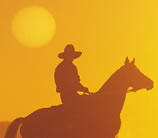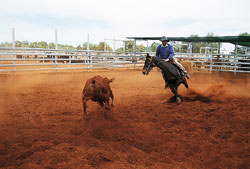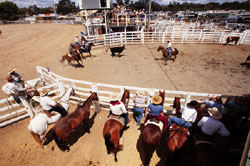



 Campdrafting: Time to take stock
Campdrafting: Time to take stockAfter thoroughbred racing, campdrafting is Australia's second largest major horse sport. But while the boom that began in the early 1990s shows no signs of waning, campdrafting may be a victim of its own success. There is no single controlling body, no major sponsors, top riders compete against amateurs and issues such as insurance liability hang threateningly over breeders, competitors and organisers.
Story Heather Brown
Photos John Elliott, Andrew Rankin and Ainslie Nielsen
When large numbers of people, many in their late teens and twenties, left the bush in the last three decades of the 20 th Century, they took with them the numbers for cricket and football clubs, arts councils and race clubs. The means of a social life for those remaining often came down to a horse, a truck and a saddle. A handful of competitors made a campdraft, a barbeque and a laugh with a beer. And so, inevitably, campdrafting's star - that had been hovering just below the horizon for decades - finally dawned.
 Campdrafting's subsequent boom has brought pleasure - and competition - to
thousands of Australians: young and middle-aged, men and women, the well-off
and the battlers, all of whom share a love of horses and horsemanship. In many
ways the integration of campdrafting into rural life has parallels with the
coming-of-age of country music. As the population was forced off farms in America
and Australia by depression, drought and poor commodity prices at various points
in their respective histories, the more songs were written to celebrate a diminishing
way of life. Campdrafting is a physical expression of the same phenomenon -
a means to revive and highlight traditional skills and traditions; a way to
take pride in what you do and who you are.
Campdrafting's subsequent boom has brought pleasure - and competition - to
thousands of Australians: young and middle-aged, men and women, the well-off
and the battlers, all of whom share a love of horses and horsemanship. In many
ways the integration of campdrafting into rural life has parallels with the
coming-of-age of country music. As the population was forced off farms in America
and Australia by depression, drought and poor commodity prices at various points
in their respective histories, the more songs were written to celebrate a diminishing
way of life. Campdrafting is a physical expression of the same phenomenon -
a means to revive and highlight traditional skills and traditions; a way to
take pride in what you do and who you are.
Full story Issue 26 Dec 2002/Jan 2003
Subscribe now and receive each bi-monthly issue for only $45 mailed to any address in Australia. Overseas rates at Subscription Centre. OUTBACK has been Australia's fastest-growing magazine for the past two years in a row.
Visit rmwilliams.com.au for R.M.Willams history, news and the on-line product catalogue